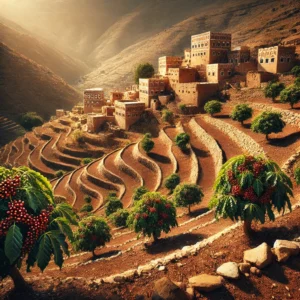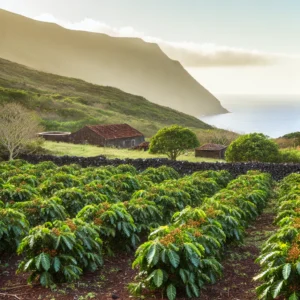In the verdant, coffee-growing regions of the world, a quiet battle is being waged. It’s not just about the land or the method, but about the very soul of the coffee bean itself. At the heart of this conflict lies a fundamental choice between two cultivation methods: shaded coffee (grown under the canopy of taller trees) and sun-grown coffee (cultivated in full sun, often after clear-cutting forests). This choice is not merely agricultural; it reverberates through the bean’s journey from soil to cup, influencing flavor, biodiversity, and even the fight against climate change.
Shaded coffee cultivation is a practice as old as coffee farming itself, where coffee bushes are grown under the protective umbrella of forest canopies. This method is touted for its environmental benefits, including preserving biodiversity and reducing the need for chemical inputs. In contrast, the sun-grown method, which gained popularity in the late 20th century due to its higher yields, involves growing coffee plants in direct sunlight, often at the expense of forest cover. However, this increase in productivity comes with its own set of challenges, including greater water and chemical usage.
The divergence between these two methods has sparked a debate among coffee enthusiasts, environmentalists, and farmers alike. It’s a debate that centers on sustainability, ethics, and, importantly, the flavor profiles that each method produces. The nuances of taste, aroma, and body that differentiate a cup of coffee are profoundly influenced by the conditions under which its beans were cultivated. As we delve into the shaded versus sun-grown coffee debate, we explore not only the environmental and ethical considerations but also the complex sensory experiences offered by each cup.
Shaded Coffee: A Symphony of Flavors
Shaded coffee farms are akin to natural forests, supporting a rich tapestry of plant and animal life. This biodiversity is not just good for the planet; it’s also beneficial for the coffee beans themselves. The canopy of trees provides a natural barrier against the sun, creating a cooler and more stable microclimate. This slower growth process allows the beans to develop more complex sugars, resulting in a richer and more nuanced flavor profile.
The environmental benefits of shaded coffee cultivation are well-documented. These farms act as safe havens for birds and other wildlife, helping to preserve local ecosystems. Furthermore, the natural leaf litter from the canopy trees enriches the soil, reducing the need for synthetic fertilizers. From a cup quality perspective, shaded-grown beans often exhibit a smoother, more balanced taste, with notes of chocolate, fruit, and nuts, reflecting the natural harmony of their growing environment.
Critics of shaded coffee often point to its lower yield and the economic challenges this presents for farmers. However, proponents argue that the premium quality of shaded coffee can command higher prices in the specialty coffee market. This premium, coupled with growing consumer interest in sustainable and ethically sourced coffees, may offer a viable path forward for shaded coffee producers.
Sun-grown Coffee: The Quest for Efficiency
In the pursuit of higher yields, sun-grown coffee represents the industrialization of coffee farming. By removing the forest canopy and planting coffee bushes in direct sunlight, farmers can significantly increase their output. This method is particularly appealing in regions where the demand for coffee outstrips the available land. Sun-grown coffee plants mature faster, allowing for more frequent harvesting.
The flavor profile of sun-grown coffee is often described as bolder and more straightforward. Without the shade of trees, the beans are exposed to more intense sunlight, leading to a faster ripening process. This can result in a higher acidity and a more pronounced bitterness, qualities that can be either prized or criticized depending on personal preference and the skill of the roaster.
However, the sun-grown method has its drawbacks, particularly in terms of environmental impact. The lack of forest cover can lead to soil erosion and requires more water and chemical inputs to maintain productivity. Additionally, the monoculture practice associated with sun-grown coffee can deplete soil nutrients and reduce biodiversity. While advances in agricultural technology and practices are seeking to mitigate these impacts, the debate between efficiency and sustainability continues.
The Impact on Farmers: Navigating Economic and Environmental Crossroads
As the global coffee market continues to expand, farmers stand at a crossroads between economic viability and environmental stewardship. The choice between shaded and sun-grown coffee cultivation methods is not just about agronomy or flavor profiles; it’s deeply entwined with the livelihoods of coffee producers and their communities. This decision impacts everything from farm income stability to long-term land usability, creating a complex web of considerations that farmers must navigate.
Shaded coffee systems, by fostering a more diverse ecosystem, offer environmental resilience against pests and diseases, potentially reducing the need for chemical pesticides and fertilizers. This method, however, typically yields fewer beans per acre compared to sun-grown systems, posing a significant economic challenge. The premium market for high-quality, sustainably grown coffee presents a potential solution, but accessing this market often requires certification and a level of production consistency that small-scale farmers may find difficult to achieve.
On the other hand, the shift towards sun-grown coffee cultivation, driven by the allure of higher immediate yields, has its own set of economic uncertainties. The initial increase in productivity can be offset by the higher costs of inputs and the potential for soil degradation and increased vulnerability to climate variability. These factors can lead to a precarious financial situation for farmers, especially as global coffee prices fluctuate.
The economic implications of choosing between shaded and sun-grown coffee cultivation are profound, requiring farmers to balance short-term financial gains with the long-term sustainability of their land and community. As the coffee industry evolves, supporting initiatives that provide technical, financial, and market access assistance to farmers adopting sustainable practices will be crucial in ensuring that coffee cultivation remains both economically viable and environmentally responsible.
Conclusion
The choice between shaded and sun-grown coffee is more than a matter of taste; it’s a reflection of the values and priorities of the coffee industry and its consumers. Shaded coffee offers a model for sustainable agriculture that prioritizes biodiversity, ecosystem health, and complex flavor profiles. Sun-grown coffee, on the other hand, speaks to the pressures of meeting global demand and the efficiencies gained through modern agricultural practices.
As consumers become more informed about the origins of their coffee and the impact of cultivation methods on flavor and the environment, the market for shaded coffee is likely to grow. This presents an opportunity for coffee lovers to vote with their dollars, supporting farming practices that align with their values. It’s a chance to contribute to a more sustainable and flavorful future for coffee.
The battle of flavor profiles between shaded and sun-grown coffee is a micro
cosm of a larger debate about agriculture, sustainability, and our relationship with the natural world. By choosing to explore and understand the nuances of our coffee’s origins, we can enjoy our daily brew as a meaningful connection to the earth and the hardworking farmers who cultivate it. The future of coffee, shaded under canopies or basking in the sun, will ultimately be determined by the choices we make, one cup at a time.



